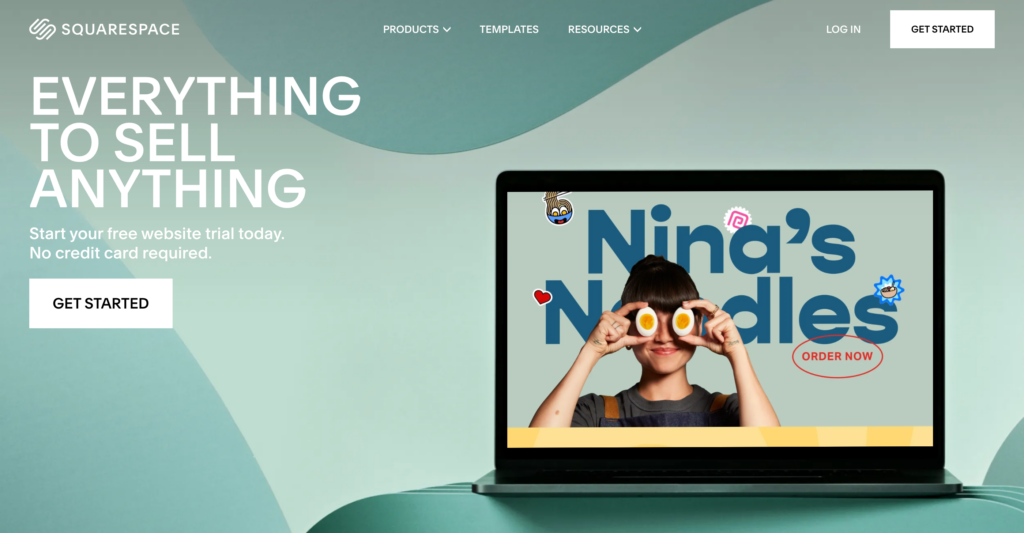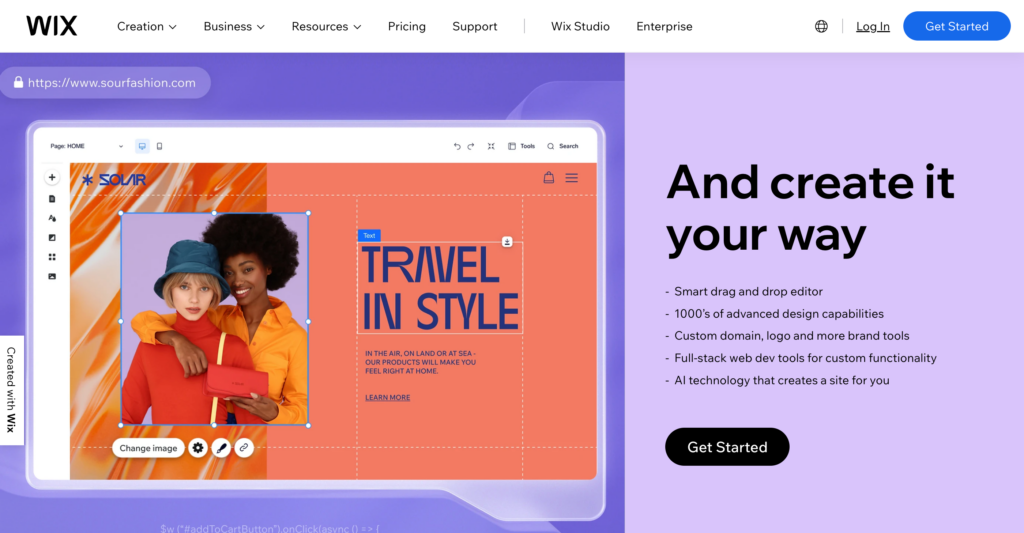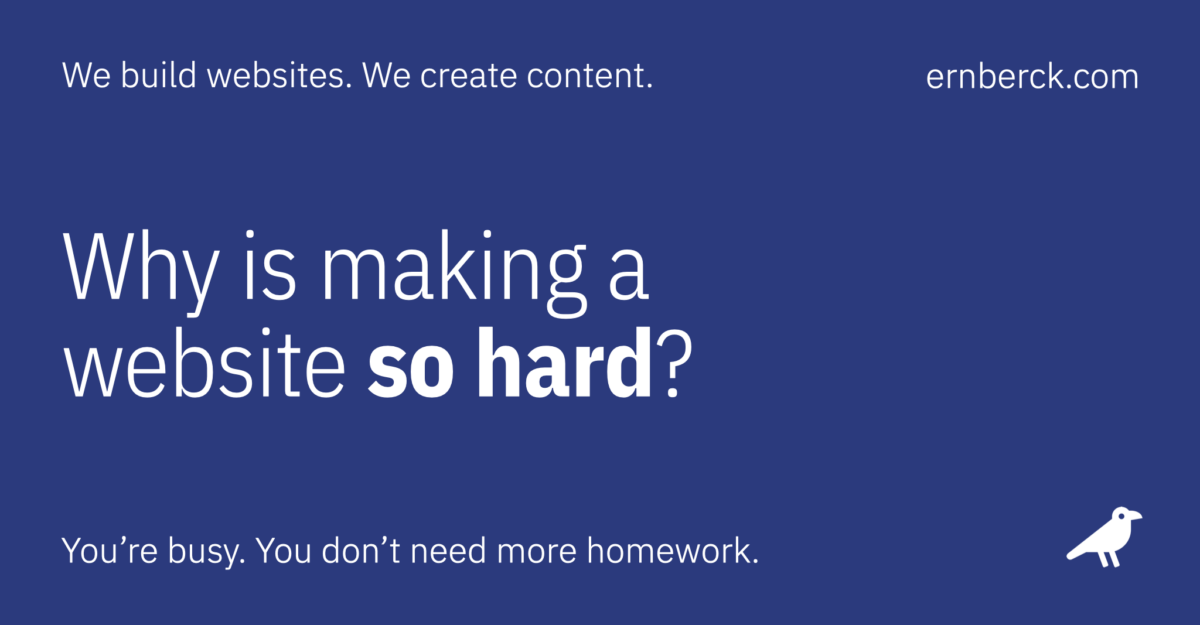Building a website can be a long and messy process, but it shouldn’t make you miserable. Whether you’re working with a designer, or going it alone, we’ve gathered a few tips to get you through it with your sanity intact.
Why is making a website so hard?
People often ask me why I build websites. I usually say it’s because the process is a delightful combination of art and science, constraint and expression, creativity and technology. Oh, and I usually sneak in the word “fun” somewhere.
What I don’t tell people is that website development is often a horribly messy and complicated process. There are dozens of parts that need to work together, hundreds of decisions to make, and the ultimate conflict of what will actually work, versus what the customer wants.
I’ve forgotten the number of clients I’ve talked to who say that their web designer is incompetent, slow, unresponsive, doesn’t understand them, or charges way too much for “simple” changes.
Why does this happen so often?
The story begins with a hyper-competitive web design industry that has zero barrier to entry. It’s filled with stay-at-home dads, unemployed moms, third-world adolescents, and “hustle bros.” What often happens is that the “designer” underbid the project to get the work, and then either can’t afford to finish it or — even worse — doesn’t know how to finish it.
The story ends with more crappy websites clogging up the internet or uncompleted sites collecting dust in some online directory. In both cases the result is the same: Disillusioned and pissed off clients who now don’t trust anyone in the web design business.

It doesn’t have to be that way
We’ve built hundreds of websites over the years, and have a good idea of what works and what doesn’t. So if you’re on a tight budget or in a hurry — or you’d like to try building a website yourself — consider the tips below.
Five simple tips to make web design more fun
Okay, maybe “fun” is overstating things, but hopefully less stressful and more economical. Plus, when you finally find a talented web designer that you like and respect, you’ll know what they’re talking about.
01. Start small
This may seem obvious, but so many folks consider it an insult if I suggest that they start their digital journey with a small and simple website. Trust me, you’ll have plenty of time to add a blog, contact forms, carousels, gated content, video, and animations (ugh). Also, it’s typically easier to add stuff, than it is to take it away.
For example, if you’re just starting out with e-commerce, the last thing you need is a $20,000 custom online store. If you’ve never dealt with shipping, fulfillment, payment processing, chargebacks, or inventory management, a better choice might be eBay, Etsy, or something similar.
Once you feel comfortable with all of the online processes, you can move up to Shopify or WooCommerce. Besides, you don’t want to drop a bundle on an e-commerce shop that may not take off.
02. Own your stuff
It can be a shock when you find out that you really don’t own your domain name. Or that your designer left the country and now you have no way to access your website. You’d be surprised at how often this happens.
To avoid these problems, make sure that you own — and have administrative access to — the following services:
- Domain name registration
- Nameservers
- Web hosting
- Email provider
Don’t worry about how all this stuff works. I’m not suggesting that you manage all these gadgets yourself — just be sure that it’s under your control (you’re the owner, you pay the bill).
With most web services you can easily delegate management tasks by adding users to your account (with permissions set by you). You can also delete them. That way you’re always in control of your online business assets.
What is a website builder?
A “website builder” is a software tool or platform that helps you create websites without the need for extensive coding or web development skills. They are supposed to simplify the website creation process, making it accessible to a wider range of users, including those with limited technical knowledge.
Website builders were originally conceived to provide a user-friendly interface and pre-designed templates that enable users to design, customize, and publish websites quickly and easily. Unfortunately, many builders have become so bloated with dubious features that “user-friendly” no longer applies.
Some popular website builders include:
- Squarespace
- Wix
- Weebly
- GoDaddy
- WordPress.com
- Webflow
- Framer
- Shopify (ecommerce)
Plus many more.
03. Use a template
A website template is a pre-designed web page — or set of web pages — that serve as a framework for creating a website.
Templates are often misunderstood and catch a lot of flack, but there’s nothing inherently wrong with them. WordPress, Squarespace, Wix — all the popular “website builders” — use templates.
The difference between a great template and a crummy one is in how they’re built and customized. Squarespace, for instance employs some fabulous designers, and their templates show it. Most of them are gorgeous right out of the box.
So if you’re strapped for cash or need a site in a hurry, use a template or a page builder like Squarespace or Wix. Just don’t change a bunch of stuff — that’s where the trouble begins. Swap out the stock images for your own (don’t “borrow”) and use your own text. Try to keep your images the same size, and your content the same length.
Note: Whenever possible, stick with the default layout, color, style, and typography settings. It’s much easier to keep track of changes when there aren’t any. If you adapt a well-built template — with or without the help of a professional designer — you can have an expensive-looking website up in a week or less.
Templates aren’t for everyone
For the sake of completeness, we should discuss a few downsides to using templates. If you’ve got a lot of unique requirements, custom web development may be necessary to achieve a fully tailored and effective website. So consider the following before making your final decision.
Despite these drawbacks, website templates can be a great option for small businesses on a budget or who lack the resources to manage a more complicated website.
Is it a template or a theme?
In the context of websites, the terms “template” and “theme” are related and often used interchangeably, but they’re not exactly the same thing. They’re both components of web design, but they serve slightly different purposes.
A template focuses on the layout and structure of a web page, while a theme encompasses the visual design and styling elements. When you choose a theme for a website, you are typically selecting both the template and the visual design to create a unified and consistent web presence.
04. Stay flexible
Your website’s not carved in stone. It’s not printed, it’s digital. It’s really easy to move things, change colors, update facts, and fix typos. Don’t freak out over stuff. It’s not like you’re publishing a half million hard copies of an 800-page book (then discover to your horror that it’s missing page 341).
Building and managing a website is an iterative process — you should be continuously improving it. You should be frequently adding pages and revising text, creating blog posts, and improving the site structure. If not, you’re doing it wrong.
Technology also changes. Much more frequently than we’d like sometimes. Be prepared for updates, upgrades, migrations, and rebuilds. It’s all part of owning a website. Don’t take it too seriously. Stay flexible and prepared and you’ll be able to handle most of what the web throws at you.

05. Have a strategy
This is arguably the most important tip, but most people forget it. Owning the coolest website in your market won’t do a thing if nobody knows about it. You need a plan, a solid marketing strategy.
Your website doesn’t exist in a vacuum. It’s just one part of online marketing that may also include digital advertising, email messaging, networking, events, and social media.
If you really want to leverage all the web has to offer, you need to connect all of these activities together to form a lead-generating business tool — Not just a website, but a marketing machine.
To accomplish that you need a carefully considered online marketing strategy that will inform how all of these elements should be integrated to best suit your business goals.
If you don’t currently have a marketing strategy — or the confidence to create one — a talented web designer or marketing agency can help you. The best designers can even point out flaws in your thinking, and help prevent expensive marketing mistakes.
Summary
Building a website can be a long and messy process but it shouldn’t make you miserable. Whether you’re working with a designer, or going it alone, we’ve laid out a few tips to get you through it with your sanity intact.
First, start with a small and simple website, gradually adding features as needed. Even more importantly, be sure that you have administrative access to key online assets like domain names and hosting services.
If possible, use a pre-made website template for quick and cost-effective design. Be proactive and flexible when making changes and updates to your website. Finally, be sure to create a well-thought-out marketing strategy to ensure the website serves as an effective business tool.
Related
Resources
Research
- Assisted by ChatGPT
